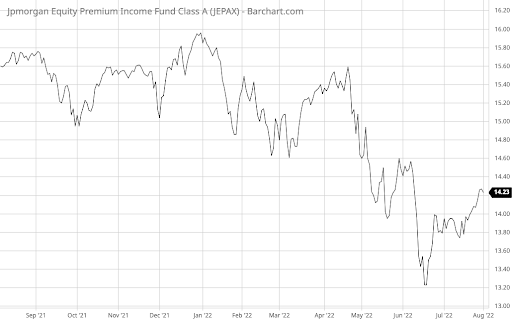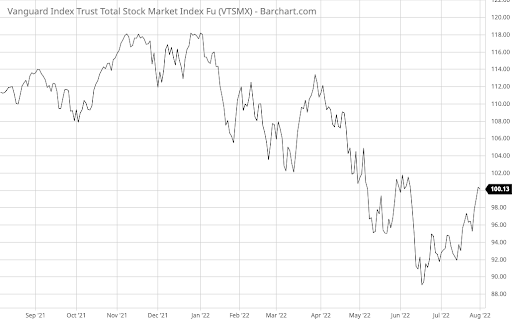First, we select the top trending category from more than 200 categories listed on MutualFunds.com based on the percentage increase in monthly viewership. Then, we choose the top three funds with the highest one-year trailing total returns from the top trending category. To ensure funds’ quality and staying power, we only look at those mutual funds with a minimum of $100 million in assets and a track record of at least three years. We also remove those mutual funds closed to new investors and not available for investment outside registered accounts such as retirement or 529.
In this edition, we take a closer look at trending Large-Cap Equity Funds for investors.
Large-cap equity funds typically constitute investors’ core equity holdings, making them an essential part of any portfolio. While S&P 500 index funds are the most common holdings in the class, several mutual funds offer different approaches to building a portfolio of large-cap stocks. And, in today’s volatile market, these alternative approaches could generate a superior risk-adjusted return.
Be sure to check out the Large-Cap Equity Funds page to find out more about the other funds in this category as well.
Trending Funds
The Vanguard Value Index Fund (VIVAX) comes first on this week’s list. It provided a trailing one-year return of 1.61% with a 0.17% expense ratio and a 2.27% yield, putting it in the middle of the road in terms of expense and yield.
The fund tracks an index of large-cap value stocks with a full-replication and low-expense approach to minimize net tracking errors. Since the beginning of the year, the S&P 500 index fell 14.5% compared to an 8.3% decline in the S&P 500 Value Index. These trends could continue if investors keep prioritizing safety over growth.
The fund’s portfolio consists of 343 stocks with an average market capitalization of $161.5 billion. These stocks have an average P/E ratio of 14.6x and an average P/B ratio of 2.4x, which is lower than the S&P 500 index’s 20.7x P/E ratio and 4x P/B ratio.
Meanwhile, the portfolio is concentrated in healthcare (21.4%), financials (18.5%), and industrials (13%), including companies like UnitedHealth Group Inc. (UNH).
Want to know more about portfolio rebalancing? Click here.

Source: Barchart.com.
2. JPMorgan Equity Premium Income Fund (JEPAX)
The JPMorgan Equity Premium Income Fund (JEPAX) comes in second. It offered a 1.06% trailing one-year return, 0.86% expense ratio, and a 9.79% yield, making it the highest yielding fund on the list.
The fund seeks to deliver monthly distributable income and equity market exposure with less volatility. Unlike the passively-managed Vanguard fund, JEPAX employs a bottom-up research process with stock selection based on the firm’s proprietary risk-adjusted stock ranks. Meanwhile, options overlays allow for flexible income generation.
The fund’s portfolio consists of about 114 stocks with an average market cap of $251 billion. Unlike many large-cap equity funds, the JPMorgan Equity Premium Income Fund invests in convertible bonds that blend the benefits of equity with the income of bonds. Aside from its 14.7% convertible bond allocation, the fund holds overweight positions in healthcare (12.9%), consumer staples (11.9%), and industrials (11.6%).
Find funds suitable for your portfolio using our free Fund Screener.

Source: Barchart.com.
3. Vanguard Total Stock Market Index Fund (VTSMX)
The Vanguard Total Stock Market Index Fund (VTSMX) rounds out the list. It provided a -9.23% trailing one-year return, 0.14% expense ratio, and a 1.34% yield, making it the lowest cost fund on the list.
As its name suggests, the fund provides exposure to the entire U.S. equity market, including small-, mid-, and large-cap growth and value stocks. With low costs, broad diversification, and potential tax efficiency, the fund provides investors with a low-cost core equity holding. But, of course, its broad approach means that investors weren’t shielded from the significant volatility over the past 12 months.
The fund’s portfolio consists of more than 4,000 stocks, making it the most diverse fund on our list. These stocks have an average P/E ratio of 15.7x and an average P/B ratio of 2.8x, making it the most undervalued fund on today’s list based on these metrics. The portfolio is overweight in technology (23.6%), healthcare (15%), and financial services (13.1%).
Learn more about different Portfolio Management concepts here.

Source: Barchart.com.
The Bottom Line
Want to generate high income without undertaking too much risk? Check out our complete Best High Dividend Model Portfolio.

